Chinese goose are considered to be the most beautiful and graceful member of the goose family. They have long and graceful necks. And because of their necks, Chinese goose are sometimes referred to as ‘Swan Goose’.
The breed is elegant and dignified on both land and water. Like the African goose, the Chinese goose is thought to descend from the native Asian wild Swan goose.
The breed is also known by some other names in some areas. For example, they are known as Oies de Chine in France and Höckergänse in Germany. They appear in two color varieties; white and brown. Both are very popular.
There are also two distinct types of Chinese goose in the United Kingdom, a heavier English dual purpose utility type of bird and an elegant exhibition strain that was introduced during the 1970s from America.
Chinese goose was brought to the United States early, and both varieties were well established in Colonial times. The breed was admitted into the American Poultry Association’s Standard of Perfection in 1874, and into the British Waterfowl Standards in 1954. Review breed details below.
Physical Characteristics of Chinese Goose
Pure Chinese goose are small breed with a graceful appearance. They have compact, short body with a prominent breast. They have long arched slender neck meeting the body at a 45 degree angle. The breed is differ from the wild birds in much larger size. And they have an often strongly developed basal knob on the upper side of the bill.
The knob at the top of the beak is more prominent on males than females. And the knob become pronounced enough by 6-8 weeks of age that it can be used for determining their gender. The knob is soft skin and not scaly and it is warm to the touch.
White Chinese goose have orange colored shanks, beaks and knobs. But the brown variety has orange colored shanks but it’s beaks and knobs are black or very dark green. Both varieties have blue eyes. They have no keels, lobes or dewlaps.
Male Chinese goose usually stand more upright than females and hold their head upright with the beak pointed upward. Females have more horizontal stances and keep their heads level or pointed slightly downward at the end of gracefully arched necks.
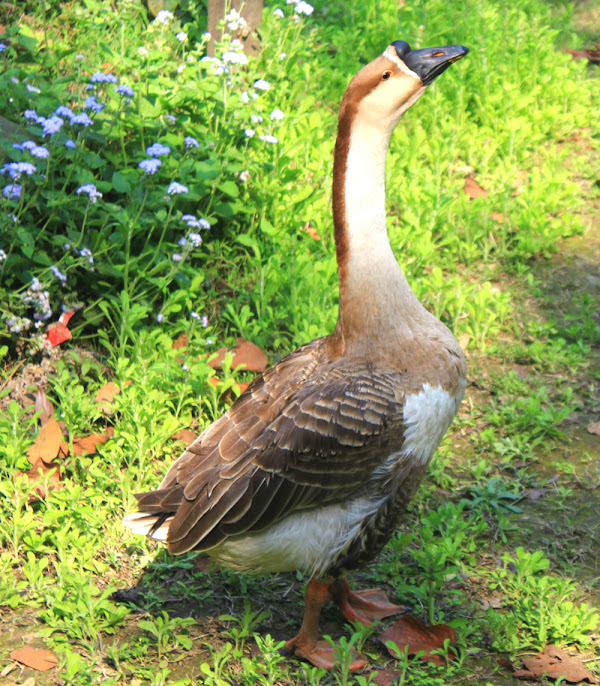
Chinese goose are comparatively smaller in size. Males are relatively larger than the females. On average males weight about 5 kg and females about 4 kg. Photo form Wikipedia.
Uses
Chinese goose are very prolific and considered as best egg laying goose breeds. But they are listed in the light class, so they are not particularly useful for meat production. They are also used as an ornamental breed and have been used as guardians.
Breed Facts
Chinese goose are not only lovely to look at, but also they are easier to raise than many other goose breeds, mainly because of their exceptional foraging abilities. They are very active foragers. And because of their great foraging abilities, they have been used as weeder goose in strawberry, tobacco and other crops.
Chinese goose are known for their high egg production capabilities. Usually they can lay between 50 and 60 eggs over the breeding season. But there are reports of Chinese goose breed laying up to 100 eggs in a breeding season.
Their breeding season normally lasts for approximately five months (February to the end of June). Their eggs are mostly white in color and average weight of an egg is 120 grams. Males are noisy and can be aggressive sometimes. Review full breed profile of this goose breed in the chart below.
| Breed Name | Chinese |
| Other Name | Known as Oies de Chine in France and Höckergänse in Germany |
| Breed Purpose | Eggs, Ornamental, Meat |
| Special Notes | Very active, great foragers, ganders can be aggressive |
| Breed Class | Light |
| Broodiness | Average |
| Weight | Standard weight is about 5 kg for males and about 4 kg for females |
| Climate Tolerance | All Climates |
| Egg Color | White |
| Egg Size | Large (about 120 grams) |
| Egg Productivity | Good (50-60 eggs per breeding season) |
| Flying Ability | Poor |
| Rarity | Common |
| Varieties | White & Brown |
| Country of Origin | China |


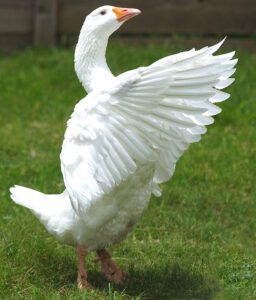
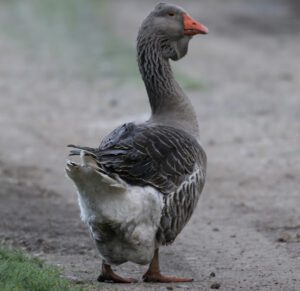

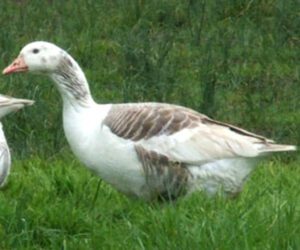
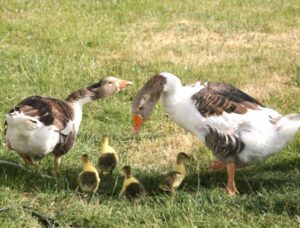
I don’t know anything about these birds but liked the look of them and bought my first 3 Chinese geese 8 wks ago reportedly 6 wks old at the time.
They still had a full down covering and started to feather up about 7/9 days later. None of them have the appearance of any nobs on their beaks, so I’m assuming they are 3 females. Would I be correct with this assumption?
Thanks Gil